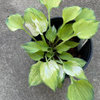H. cathayana vs. H. 'Lancifolia' ?
OK H.'Gurus': enlighten me and many others I suspect. I've just scratched the surface and think I have both. But I sure can't tell from photos I have found so far, or convincingly from data. The most convincing is that one hosta in question has been in my family for 20 years and I have never seen a seedling. The other only 4 years and I have dozens of seedlings.
Historically, 'Lancifolia' has been propagated in Western culture, but the species cathayana must predate that yet identified in 1940 and AHS registered in 1993. It would make sense that for centuries cathayana was believed to be 'Lancifolia' (using only the names we know now-but speaking of the actual species and cultivar).
---------------------------------------------------------------------------
THE QUESTION FOR YOU
Assuming I have both, does anyone else even suspect you also have both. If so please join in with me here. Is there any way you can physically tell the difference other than viability? My general impression is that cathayana is slightly smaller in both clump and leaf size, slightly the glossier, slightly darker green, and slightly deeper purple flowered.
--------------------------------------------------------------------------
Both suspects are mature but the one I believe to be 'Lancifolia' has been in its garden spot 12 years and babied; the H. c only a couple of years, and untended.
All the time I might as a little girl been tip-toeing through H. cathayana, not H. 'Lancifolia'. It is just one more thing I'd like to know B4 it is too late. Going by dates of origin it must have been 'L' since I was a young girl in the 1940's. BUT, if everyone didn't know the difference between the speciies sometimes known as Akakaze Giboshi and the other as Kobi Giboshi, there is no way to tell. I have no way of knowing if my Grandmothers huge patch came from seedlings or spreading. I tend to think through seedlings, but she was a very adroit gardener. She may or may not have planted them. There is no one alive today to tell me.
I am hoping to start as close to a base-line as possible and perhaps end with definitive results. Moc, I KNOW you want to see in your lovely collection one of every hosta that is a survivor. I also know many GWHF members are like us.
I think my own list of around 100 has just grown by one. But which is which? Either way I think both hostas in question are very near the top of the list of hosta survivability.
Theresa










mosswitch
ken_adrian Adrian MI cold Z5
Related Professionals
Garden City Landscape Architects & Landscape Designers · Redondo Beach Landscape Architects & Landscape Designers · Chelmsford Landscape Contractors · Chesapeake Ranch Estates Landscape Contractors · Davidson Landscape Contractors · East Lake-Orient Park Landscape Contractors · Holland Landscape Contractors · Lynwood Landscape Contractors · Shirley Landscape Contractors · Fairfax Driveway Installation & Maintenance · San Antonio Fence Contractors · Woodland Hills Fence Contractors · Bridgeport Solar Energy Systems · Elizabeth Solar Energy Systems · Shelton Solar Energy Systemsjan_on zone 5b
mosswitch
Steve Massachusetts
gogirlterriOriginal Author
gogirlterriOriginal Author
ken_adrian Adrian MI cold Z5
gogirlterriOriginal Author
gogirlterriOriginal Author
idiothe
ken_adrian Adrian MI cold Z5
gogirlterriOriginal Author
johnnydc23